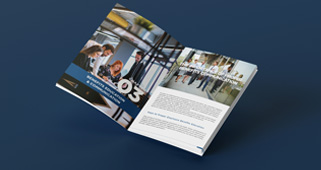When your company is small, insurance feels simple. A basic health plan, maybe some dental and vision coverage, and you’re set. But as your organization scales from 20 employees to hundreds, your insurance needs change dramatically.
Each growth stage brings new regulations, new risks, and new employee expectations. Employers who anticipate these shifts can save money, stay compliant, and attract top talent along the way.
At Benely, we help businesses navigate this journey. Whether you’re at 20 employees or preparing to scale past 500, we design insurance and benefits strategies that fit your size, budget, and culture.
This guide will walk you through how insurance offerings typically evolve as your company grows—from 20 employees to 500+—so you can plan ahead with confidence.
Stage 1: 20–49 Employees – Building the Foundation
At this stage, most companies are still lean. HR is often handled by the owner, office manager, or a single HR generalist. Budgets are tight, but employees expect core benefits.
Health Insurance
- Group Medical Coverage: Most states allow companies with 20+ employees to access more competitive small-group or level-funded health plans.
- Plan Designs: High-Deductible Health Plans (HDHPs) paired with Health Savings Accounts (HSAs) are common to balance affordability.
- Employer Contribution: Often 50–75% of employee-only premium, with dependents covered at employee expense.
Ancillary Benefits
- Dental & Vision: Typically offered as voluntary (employee-paid) but available at group rates.
- Basic Life & Disability: Employers often provide a small amount of group life insurance (e.g., $25,000) and short-term disability coverage.
Compliance Considerations
- COBRA applies once you reach 20 employees. You must offer continuation coverage to departing staff.
- Some states (like California) mandate additional paid sick leave or disability coverage.
Employer Goal
- Keep costs manageable while offering enough to attract and retain employees.
👉 Benely Tip: At this stage, many companies benefit from a PEO (Professional Employer Organization) partnership to access better insurance rates and compliance support.
Stage 2: 50–99 Employees – Expanding Coverage
Reaching 50 employees is a major milestone. Why? Because it triggers the Affordable Care Act (ACA) employer mandate.
Health Insurance
- ACA Requirements: Employers with 50+ full-time equivalents must offer affordable, minimum-value health insurance or face penalties.
- Plan Options: Employers start offering multiple plan tiers—such as an HDHP and a PPO—so employees can choose.
- Employer Contribution: Typically rises to 70–80% of the employee-only premium.
Ancillary Benefits
- Voluntary Benefits Grow: Employees at this stage expect dental, vision, life, and disability.
- Employee-Paid Enhancements: Critical illness, accident, hospital indemnity, and pet insurance are increasingly popular.
Compliance Considerations
- ACA reporting requirements (Forms 1094-C and 1095-C).
- Tracking variable-hour employees for eligibility.
- State-specific mandates (paid family leave, disability, etc.).
Employer Goal
- Stay compliant with ACA while becoming competitive in the benefits market.
👉 Benely Tip: Companies in this range should conduct annual benefits benchmarking to ensure they remain attractive compared to competitors.
Stage 3: 100–249 Employees – Professionalizing Benefits
By now, your company likely has a dedicated HR or People team. Benefits become a strategic tool, not just a checkbox.
Health Insurance
- More Plan Options: Three or more health plan options, often with different carrier networks.
- Self-Funding Options: Employers begin exploring partially or fully self-funded health insurance to control costs.
- Wellness Programs: Preventive care initiatives, gym discounts, and telemedicine gain traction.
Ancillary Benefits
- Employer-Paid Life & Disability: Employers often cover baseline life (1x salary) and disability insurance.
- Expanded Voluntary Benefits: Legal services, identity theft protection, student loan assistance.
- Mental Health Resources: Employee Assistance Programs (EAPs), teletherapy access, mindfulness apps.
Compliance Considerations
- Non-discrimination testing for self-funded or Section 125 cafeteria plans.
- ACA affordability testing becomes more complex.
- More rigorous COBRA and FMLA administration.
Employer Goal
- Differentiate as an employer of choice while keeping rising costs under control.
👉 Benely Tip: Many companies in this size range save 10–20% by leveraging self-funded or level-funded medical plans with strong stop-loss protection.
Stage 4: 250–499 Employees – Scaling for Growth
Companies of this size are seen as “mid-market employers” and face increased complexity in benefits management.
Health Insurance
- National Carriers & Networks: Larger employers negotiate directly with carriers for multi-state coverage.
- Custom Plan Designs: Employers may design their own plan structures with wellness incentives.
- Onsite or Virtual Clinics: Larger employers begin offering onsite nurses or partnerships with virtual primary care providers.
Ancillary Benefits
- Robust Benefits Menu: Dental, vision, life, disability, voluntary benefits, EAP, and wellness programs are standard.
- Retirement Plans: 401(k) with employer match becomes common, with automatic enrollment features.
- Learning & Development Benefits: Tuition reimbursement and professional development stipends expand.
Compliance Considerations
- Multi-state compliance challenges (paid leave, disability, etc.).
- 5500 filing requirements for benefit plans.
- HIPAA privacy and data security become higher priorities.
Employer Goal
- Balance cost control with the need to provide comprehensive, competitive benefits to attract top-tier talent.
👉 Benely Tip: Employers in this size range benefit from benefits technology platforms that streamline enrollment, administration, and compliance across states.
Stage 5: 500+ Employees – Enterprise-Level Complexity
Crossing 500 employees puts your company firmly in the large employer category. Benefits become highly complex and require advanced strategies.
Health Insurance
- Self-Funding Dominates: Most companies this size self-fund their medical plans with stop-loss coverage.
- Data-Driven Strategy: Employers analyze claims data to drive wellness initiatives and cost-containment programs.
- Custom Networks: Direct-to-provider contracts, narrow networks, or Centers of Excellence partnerships.
Ancillary Benefits
- Comprehensive Offerings: Every core and voluntary benefit, often with employer subsidies.
- Global Benefits: If the company operates internationally, global health coverage and expatriate plans.
- Enhanced Perks: Fertility benefits, gender-affirming care, eldercare support, adoption assistance.
Compliance Considerations
- ERISA fiduciary responsibilities are closely scrutinized.
- Enhanced reporting requirements (5500, PCORI, etc.).
- Greater focus on DEI compliance in benefits design.
Employer Goal
- Use benefits as a culture driver and competitive differentiator in a global talent market.
👉 Benely Tip: At this scale, companies often save millions by implementing data-driven wellness and cost-management strategies, such as direct contracting or onsite care.
Comparative Snapshot: Benefits by Growth Stage
| Company Size | Health Insurance | Ancillary Benefits | Compliance Focus | Employer Goal |
|---|---|---|---|---|
| 20–49 | Basic group health, HDHP + HSA | Dental/vision (voluntary), small life/disability | COBRA, state mandates | Affordable coverage |
| 50–99 | ACA-compliant plans, multiple tiers | Voluntary add-ons (accident, critical illness) | ACA reporting, affordability testing | Compliance + competitiveness |
| 100–249 | Self-funded options, wellness programs | Employer-paid life/disability, EAPs | Non-discrimination testing | Strategic differentiation |
| 250–499 | National carrier negotiations, custom plans | Full menu of voluntary & retirement benefits | Multi-state compliance, 5500 filing | Balance cost + talent needs |
| 500+ | Self-funded with data analytics, custom networks | Comprehensive + global benefits | ERISA fiduciary duties | Competitive edge in global market |
Final Thoughts
As your company grows, your insurance and benefits strategy must evolve. What works for a 25-person startup won’t cut it for a 250-employee mid-market company—or a 1,000-person enterprise.
The good news? You don’t have to figure it out alone.
At Benely, we partner with businesses across every growth stage. Whether you’re building a foundational package, navigating ACA compliance, or designing a sophisticated self-funded plan, we provide:
- Expert guidance
- Access to exclusive carrier and PEO discounts
- Technology solutions
- Strategic plan design
Ready to design a benefits package that grows with you? Contact Benely today to learn how we help companies from 20 to 500+ employees deliver competitive, cost-effective insurance solutions.






